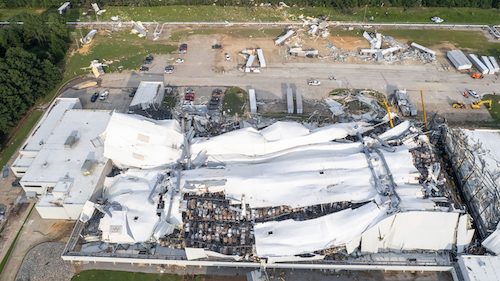July 2023- The Journal of Healthcare Contracting
In the constant search for ways to cut costs across the board, one of the biggest points of debate for IDNs and providers is the decision between domestic or international manufacturing for their supplies. The pandemic illuminated the need for increased manufacturing in the United States as the demand for PPE and other materials skyrocketed. Companies without any onshore manufacturing were much more likely to struggle with sourcing materials for their clients, but the labor and raw material costs make domestic manufacturing harder to maintain for others. Essentially, it comes down to the needs and goals of the company.
The Journal of Healthcare Contracting publisher John Pritchard recently sat down with several supply chain leaders to discuss the merits of investing in U.S.-based manufacturing for providers:
- Rene Gurdian, Assistant Vice President of Supply Chain Finance and Strategy at Ochsner Health
- George Godfrey, Chief Supply Chain Officer at Baptist Health South Florida
- Bob Boswell, President and CEO at LeeSar & Cooperative Service of Florida
- John Wood, CEO of Encompass
Changing sourcing strategies after COVID
Because of the pressures that COVID created for the healthcare supply chain, many organizations had to look for new sourcing strategies to improve supply chain assurance across the board. The biggest thing we learned from COVID is the lack of transparency and visibility around distribution and manufacturing, which led to the discovery of counterfeit products that did not meet the compliance standards required for their use in a healthcare setting. “We didn’t know where they were coming from. We didn’t know what types of challenges we were coming up against overseas,” Gurdian said.
At Ochsner, their Supply Chain leadership group has invested in several resiliency tools to better understand the bill of materials outside of the United States. This information provides their supply chain an improved transparent landscape that provides insight into the raw materials Ochsner is purchasing, which provides an opportunity to align long-term contingency plans on potential upcoming disruptions. Gurdian said, “At Ochsner, our overarching goal is to try to educate our team members, whether it’s a par technician or a contract analyst, that while [these individuals] are not at the beside directly, we are five to six degrees separated and we can potentially impact patient experience as well in tandem with the clinical experience.”
Patient care is of course the top priority, and that starts in places like supply closets. With the labor challenges facing healthcare within the nursing community, Gurdian used the example of hard-working nurses that need to spend time taking care of their patients, but that time is limited when they cannot locate the right products in the right place due to disheveled supply closets. “At Ochsner, we pride ourselves on the format of PAR closets (supply closets) and products being in a place that nurses can quickly locate the product and return to the bedside to be with their patients.”
Godfrey’s team at Baptist Health is among the many that have struggled with item substitutions in the last few years. These companies that struggled with item substitutions faced prices that increased as high as 200% for out-of-contract transactions. When organizations like Baptist Health are tied up in a contract that cannot procure the items they need, they have to source the items on an off-contract basis.
“Historically, supply chains don’t have the reporting capabilities to understand the complexities in item substitutions,” Godfrey said. “We go through contract renewals; we have a process in place. We understand increases and decreases, but when it comes to item substitution and you are in the hand-to-hand combat of getting supplies for the patients, the tools and analysis are not robust.”
The application of technology can be tricky when it comes to the human element of your organization. Automating your processes and applications after COVID might seem like an obvious choice to make, but it shouldn’t be at the expense of your team.
Godfrey said, “We look at technology not to replace people, but more to enable our people to do an outstanding job at what they are called to do. Whether it’s using technology for workload management or deploying supplies into one of the 1,100 supply cabinets we manage across 12 hospitals, we try to be innovative at everything we do. Additionally, if we are trying to drive success in certain areas, we are trying to measure success as we go along.”
Other organizations decided to improve their predictive analytics to improve their sourcing processes. At LeeSar, Boswell said through predictive analytics, they were able to leverage material resource planning capacity. He said, “We started leveraging more technology and freeing up our sourcing specialists and buyers to focus more on back orders. We also generate a daily pulse report that is a byproduct of our IT system. With this pulse report, we know the status of all inventory locations, current backorder and auto-sub status, raw and adjusted fill rates.”
Changing manufacturing processes after COVID
Sourcing strategies are among many things that have changed in the wake of COVID-19. If American manufacturing is going to be a viable option for providers going forward, there are things that need to change to make it more available for providers.
One of the biggest challenges facing domestic manufacturing is finding the people to fill these jobs. Labor costs and operational costs are higher for domestic manufacturing, but these costs can be offset with improved quality standards and smaller shipping windows.
For Encompass, John Wood and his team are considering shifting their manufacturing processes to nearshore instead of onshore.
“We have manufacturing in the U.S., but we have a big focus on moving to nearshore,” Wood said. “The mission for Encompass is really focused on the fact that we believe every patient, resident, caregiver, and family member needs to feel safe and comfortable in the healthcare environment. Safety is the biggest part of that, and the way we can assist people is by creating innovative products that are reliably delivered and cost effective.”
Nearshore sourcing allows for improved shipping windows from offshore sourcing. Wood said that a facility in China would have to guess what customers need three months in advance, but a nearshore facility in Mexico could drastically reduce that window.
From Wood’s perspective, COVID has forced his team to be better at what they do. “The big problem through COVID was the difference in lag time in the cost system. On the manufacturing side, we were getting price increases six months before.”
Wood believes whatever challenges that providers face in supply chain are due to “something in the chain that shouldn’t be there,” not because the healthcare industry is erratic. He said, “It’s complicated, right? You’ve got distributors, manufacturers, providers, GPOs. It’s become quite a complex system. I would say we do a better job with our direct IDNs because we have salespeople who go out and help us implement programs.”
The future of American manufacturing
Are we prepared for another pandemic? Another supply chain gridlock? What happens if another significant disruption upsets the balance again? The answer is complicated, but introducing more American manufacturing could be the key to avoiding some of the challenges that came from the coronavirus pandemic.
Gurdian said, “I think what we’ve learned is that there was a lack of transparency and education between the sales side of the suppliers to the supply chain side of the suppliers. I can sell products all day, but that doesn’t mean that I know how it’s made or where it comes from. What I’ve requested from any of the vendors that we talk to is to make sure that their team feels empowered to get some cross education with their peers in their organization within their organization’s supply chain department to really understand the products they are selling. It’s great to get a sale, but it’s not good if the product doesn’t show up.”
There’s of course a bit of give and take when it comes to engaging in domestic manufacturing. Onshoring manufacturing for healthcare companies will require higher labor and operational expenses, but it will also ensure the quality of the material and decrease shipping rates. Being able to visit the facilities for quality checks is a huge bonus for buyers, and it would have been a major advantage for healthcare organizations that were struggling with counterfeit products during the height of the pandemic. Ocean freight prices are astronomical, and it takes much longer for supplies to get in from an offshore source.
Another thing to consider for those looking to make a switch is the performance of their suppliers. Have you had difficulties in getting the supplies you needed? The quality of your supplier is a huge component to the success of your organization. “What we look at is supplier performance,” Godfrey said. “We are trying to move business away from the suppliers that do not manage their business very well.”
“At the end of the day, the most important thing is that patient care is not being compromised. Our first priority is to secure the supplies regardless of the source. In doing this there is a natural migration to the better performing and more consistent suppliers. Noble intentions are to support more domestic manufacturing and suppliers; the reality is that currently there are cost factors and limited supply in that space,” Boswell said.
Increasing American Manufacturing in the Wake of COVID-19 – The Journal of Healthcare Contracting (jhconline.com)


